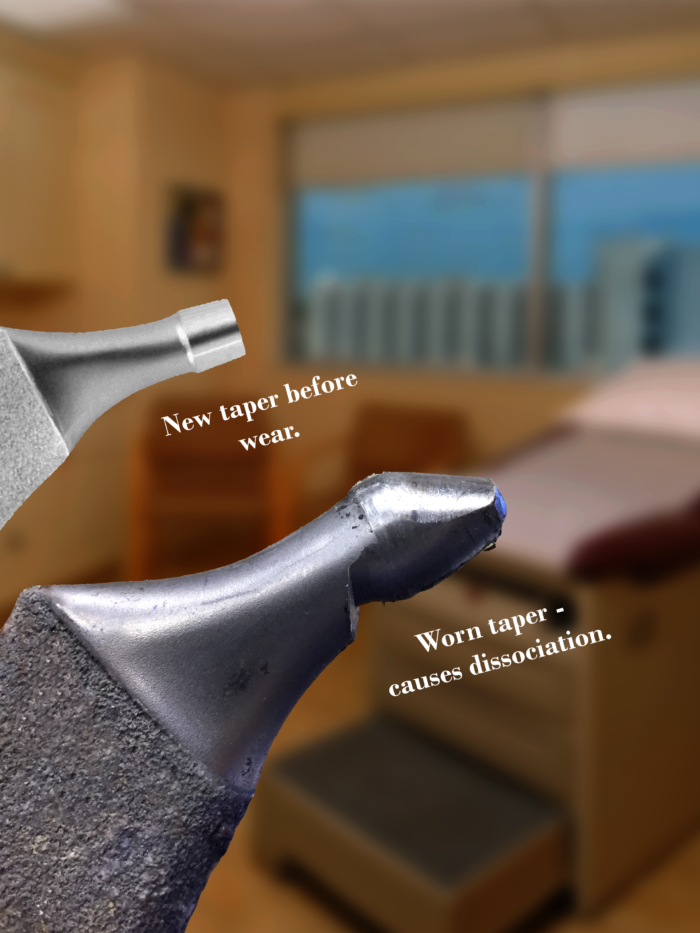Are Stryker V40 Femoral Heads (CoCr) Defective?
Stryker V40 Femoral Heads (CoCr) Associated With Spontaneous and Catastrophic Head-Neck Dissociation
Stryker may face yet another crisis associated with their total hip replacement medical devices – and this time it may be related to its large LFIT-V40 chrome/cobalt heads. These heads have been reported in medical literature to potentially cause catastrophic dissociation or metallosis requiring revision surgery. The company faced a major recall in 2012 with the recall of its popular Stryker Rejuvenate and Stryker ABGII modular stems.
Mechanism of Defect
Problems stem from potential corrosion at the head-neck juncture of the prosthesis – this corrosion weakens the important juncture between two key pieces in implant design, the head (the metal ball which fits within the acetabular shell) and the neck of the stem connecting the head to the rest of the prosthesis. When the connection between these two pieces becomes corroded within the body, the potential for a catastrophic dissociation increases significantly.
Catastrophic dissociation sounds a lot like a dislocation of the hip joint. This is not the case – the effects of this defect can be much more severe than a typical metal corrosion case. With catastrophic dissociation, the actual neck of the stem is weakened to the point of breaking. Many photographs in the medical literature show the neck of the stem being ground into a thin point.
In typical metal-on-metal cases (MoM), the head and the liner (or acetabular shell) are both made of similar metals, usually cobalt, chromium, molybdenum and/or titanium. This friction, or wear, can cause a corrosive process which can cause severe pain and the need for revision as well as elevated metal levels resulting in a condition known as “metallosis.” While this possible defect of LFIT V40 metal heads can cause symptoms similar to a MoM case (like the DePuy ASR and Stryker Rejuvenate recall), the end result of this corrosion can be far more injurious to patients’ health through dissociation of the stem and the metal head.
Patient Outcome and Damages
In the DePuy ASR litigation, patients usually were forced to endure a revision focused on exchanging the ASR acetabular shell (or cup) with a new, non-metal (polyethylene or ceramic) bearing surface. This revision is the most common and least invasive revision a total hip arthroplasty recipient can undergo. Serious problems can always occur after any surgery, and many DePuy ASR victims required multiple revisions, suffered dislocations after revision, and/or caught infections in the hospital setting.
The damage to a patient in a case of catastrophic dissociation can be much more severe than the previously described scenario. If corrosion has eaten away at the neck and has caused a break at the head-neck junction, the patient will have to undergo a much more invasive revision surgery with complete removal of what is frequently a well in-grown stem. A complete removal of the stem was necessary in the more recent Stryker Rejuvenate and ABG II litigation. In that litigation, the failure mode was at the neck/stem junction (which was modular) and due to corrosive wear at the stem, required full stem removal.
Removal of a well in-grown stem is a very serious operation and fraught with potential complications. Many surgeons won’t even try to perform this operation and instead refer their patient to a specialist.
The operation is very challenging because the stems are designed to promote the patient’s bone to grow into the stem’s rough surface and virtually all do. This makes the stem a permanent part of the patient’s femur bone. Removal requires breaking the stem free from the bone which often fractures the femur. Some cases are so severe; they require the surgeon to perform an extended trochanteric osteotomy. This procedure involves cutting the femur in half, removal of the stem and then wires and cables to put the femur back together so a replacement stem can be placed.
As with all cases requiring stem removal due to metal wear disease, revision surgery does not solve many long term problems patients may experience such as permanent soft tissue, muscle and bone destruction caused by the metal wear debris. Surgeons admit that they cannot remove that debris from the hip tissues so it remains in the patient after the defective stem is replaced with a new one.
If you think you may have a Stryker V40 Head or a Stryker Accolade TMZF stem and are experiencing pain potentially caused by metal corrosion or have suffered a spontaneous dissociation necessitating full revision and emergency care, please call us.
Share This



